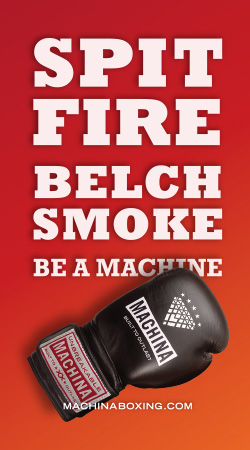There’s a scene in the movie Hoosiers where the coach of the small town Indiana basketball team gathers his players and together they measure the opposing team’s home court dimensions in order to prove the point that, although their opponents come from the big city and play in a big arena, it’s still a regulation size court no different than their own. You’ll never see that scene in a boxing movie. Rocky Balboa could train everyday in a 18 foot ring and then finally face Apollo Creed for the world title in a 22 footer. Like a lot of things in the sport of boxing, there’s very little consistency and plenty of randomness.
Ring dimensions can see wide differences in amateur and professional bouts alike. Governing bodies allow rings for professional matches to fall within a range of usually 16 to 25 square feet (the dimensions inside the ropes), while amateur rings can be anywhere from 16 to 20 square feet - all depending on individual state commissions. Since every fighter has their own style, the size of the ring can either complement or contrast with how they fight as well as with what they’re accustomed to from training. Sometimes big name fighters will actually pay off an opponent in order to arrange a ring size they prefer.
A smaller ring can provide a pretty exciting fight since there is nowhere to run. In Pennsylvania, home of Machina Boxing, pro rings can run the full gamut of 16 to 24 square feet, offering a variety of spectacles. Many notable matches once took place at the Legendary Blue Horizon in Philadelphia, a former venue that lived up to its name, where the ring was specified as the minimum 16 feet, although many agree it was probably a shade smaller! If you were a spectator who loved seeing big action, the Blue Horizon was for you. And indeed, it was a popular fight location in its time.
The Legendary Blue Horizon in Philadelphia
Some relatively consistent details of current boxing rings include the canvas and ropes. The canvas is typically padded with a thin layer of foam and should extend about two feet beyond the ropes. This extra portion of the canvas is known as the "apron". There are 4 ropes surrounding the ring, which are at least an inch in diameter and about one foot apart with the bottom rope about 18 inches above the canvas.
So why is this squared enclosure called a “ring”, you ask? Well, a long time ago bare fisted contests took place in an area that was often designated by drawing a circle in the dirt or simply by a crowd of spectators who would form into a circle naturally. Then in the very early days of fighting as organized sport, the contests started taking place in squared pens called “rings” that included a circle painted in the center where the fighters would meet at the start of each round. Nowadays the fighters emerge for each round from their respective corners and, while the action begins with the opponents circling each other, the name “ring” is simply a relic of centuries ago.

